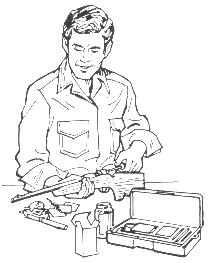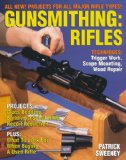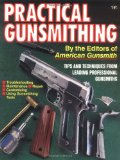Articles on Gunsmithing
Gunsmithing tips that can save us all time money
Gunsmithing Tips That Can Save Us All Time And Money Slotting a small washer or a one-cent piece to slip over the end of your long square-shanked, buttstock screwdriver, will fit over 90 percent of the buttstock holes, and will act as a guide to lead the screwdriver tip into the screw slot. Using a square shaft screwdriver enables you to use an adjustable wrench to break loose and turn out rusted-in or tough screws.
Gunsmithing the model 788 Remington
Discontinued Remington M-788 rifles which originally cost about $90 handle such cartridges as the 6mm Remington, .22-250, 7mm-08, .257 Roberts, .308 Winchester and the 7×57 Mauser (rifles were also chambered for the .223 head-size calibers). Their bulk, weight, rigidity and minimal magazine and ejection port cut-outs gives them many of the attributes sought by the super-accurate benchrest shooters.
Homemade Stuck Case Remover Tool
Sooner or later you’ll end up with a case stuck inside resizing die.
Fine Tuning Brass Resizing
Resizing Die Adjustment, Fine Tuning for the Mil-Surp Rifle Chamber
Measuring Headspace
Headspace is the measurement between two points in a rifle’s chamber. These points are the boundaries of cartridge movement when a cartridge is chambered. In strict SAAMI terms headspace is the distance from the face of the closed breech of a firearm to the surface in the chamber on which the cartridge case seats.
Do-It-Yourself Gunsmithing Parts And Accessories For Colt And Ruger Single-Actions
Custom pistolsmiths are doing a thriving business providing a service for those who prefer their sixguns a cut above. Rechamberings are big these days with .44 Magnums becoming .45 Colts, .475 and .500 Linebaughs. In these pages, I have reported on many of the metal-smithing craftsmen who perform their magic. They are nearly as important to me as my doctor. However, there are many things that we can do ourselves to upgrade our sixguns, especially single-actions.
Yes, you can! – Shotgunner
The arrival of Brownells’ latest No. 56 master gunsmithing catalog reminded me how easy it is today to repair or make modifications to your shotgun with nothing more than simple hand tools, if that. And it’s a recent development. For decades, shotgun gunsmithing was a rather arcane craft. American gunsmiths, in general, tended to gravitate to the rifle and handgun business, and most of the available gunsmithing books reflected that bias.
Firelapping For Accuracy
Got a rifle that’s giving you trouble? Before you spend money on gunsmithing, try this simple but effective accuracy-tuning procedure that’s as easy as a trip to the range. The idea of using an abrasive compound to polish the inside of a rifle barrel is hardly new. The practice of lead lapping certainly dates to the early days of centerfire cartridges and perhaps even further back into the days of muzzleloaders. The concept is actually pretty simple. A steel rod is inserted from the breech end of an unchambered barrel and stopped an inch or two from the muzzle. Then, molten lead is poured into the bore to form a lead slug.
Building a dream rifle of your own
With simple hand tools and the resources of a few specialized firms, you can build your own dream rifle. It’s never been easier, and once you’ve gone through the learning curve of puffing together that first rifle, it won’t be your last. Here’s the story of my new .338.
Keep em clean: Good firearms deserve good care. Here are a few thoughts on the subject from the Guns staff
March down to your local gun shop, and odds are that you’ll find a wide variety of products designed to clean, lubricate and/or preserve the finish of your fine firearms. Unless your local shop is particularly well stocked, you can look at the assortment of different concoctions on the shelf, multiply that number by about 15, and you’ll be close to the actual quantity of such products available on the market. Out of this staggering variety, which products are actually the best for your uses? The only person who can answer that question is you. You’ll want to experiment to learn for yourself what works well, but you will probably also observe what your shooting and hunting partners tend to use. That is the idea here.
Long-throating barrels can provide higher velocities
Many hunters and gun owners place unrealistic emphasis on velocities their rifles are capable of. Shortly after WWII, the large case capacity “Weatherby” cartridges commenced their trek to near immortality. At that time, many shooters didn’t realize that chambers such as the .30O Weatherby magnum were long throated about 3/4-inch (called free-boring). This means the rifling was cut away at the throat of the barrel to allow bullets to jump 3/4-inch before engaging the rifling. This, coupled with the high velocity, gives them a double recipe for shorter barrel life and accuracy loss.
Re-choking obsolete .410 shotguns
For years there was no easy solution for restoring single barrel shotguns. Once the original choke was either blown out via obstructions in the barrel, or the tapered tubes that screwed onto some of the muzzle-slotted collets cracked and were no longer available, the shotgun was useless for its purpose. Then came B-Square’s heavy roller type swaging tool with which our shop has re-choked numerous single barrel shotguns.
It’s a Gas
John Browning patented the basic idea of a tilting barrel in automatic pistols in 1895. That feature is one of the great strengths of the 1911 pistol; it is also one of the Government Model’s greatest weaknesses.
“Chisel” case extraction is a hopeless matter
A city gun shop quoted a fair enough price to a customer for removing a ruptured cartridge case from an old Mauser 7mm that had been converted to a .308 Winchester — by shortening a 1903 Springfield .30 caliber barrel, threading and chambering.
The Clean-Up After
Most surplus ammo on the market today is corrosive. Usually the primer is the culprit, when fired it coats the inside of the firearm with corrosive salt residue. When the salts combine with moisture, damage starts to occur to the metal surfaces. Oils or petroleum based products will not break down the corrosive salts and therefore are ineffective in cleaning or neutralizing the salt compounds.
Measuring Cartridge Over All Length (OAL) in a Mil Surp Rifle
One question, which seems to crop up quite often is: How far out should a bullet be seated to give best accuracy in a mil-surp rifle? Different Loading manuals can often cloud the issue further by listing various lengths for the same cartridge. Sporting rifles and mil-surp usually give best accuracy with a bullet seated 0.015 to 0.030 inches back from the lead in the barrel proper. Chambers in most mil-surp rifles tend to be on the roomy side. This give added insurance against jamming and high pressure, because the soldier on the battlefield may not have time to properly clean his rifle.
Lightening the SKS Trigger
Installing replacement trigger springs in an SKS
How to re-cock and reinstall a Mauser bolt
“I had my 98 Mauser bolt out of my rifle to disassemble and something happened and now I can’t get the bolt back into the rifle.”
Gunsmithing – Sights and Scopes
Adjusting the Front Sight of the Mosin-Nagant
Staying Level and Centered
Scopes, Bases, Rings & Rifles; Making It All Come Together
B Square Scout Mount On a Mauser 1916
How to mount a B Square Scout mount on a Mauser 1916
Front Sights for Enfield Rifles & for Mauser Rifles
Most WW I and WW II military leaders and planners anticipated battle lines of the Twentieth Century would be approximately 250, or more, meters apart. Therefore, they ordered rifles should be zeroed for that distance and trained their infantry to shoot at long distance targets. The extremes of this thinking are evidenced by the volley sights such as we find on the Lee Enfield No.1, Mk III Rifles of WWI. Volley sites allowed infantry to ACCURATELY place fire upon opposing troops at distances over 1,000 meters or more.
Receiver sights are not so obsolete – sights for sport and hunting guns
Today’s gunsmiths probably install more scopes than any other types of sights. This does not mean receiver sights, often referred to as peep sights, are dead. Knowledgeable, practical, gun educated hunters have them in their working batteries of game getters. They are less cumbersome, faster, easier to manipulate into and out of gun cases, saddle scabbards, other fast handling needs, plus are easier, faster and cheaper to install than scope and mounts.
Scoping the Enfield No. 4
No gunsmithing required to put a scope on that Enfield. Attaches solidly to the receiver using the ejector and safety screws. Quick detachable, Weaver-style base is machined to extremely close tolerances for precise return to zero. Installation requires no bolt modification or rear sight removal. Leveling adjustments adapt mount to a wide range of receivers; windage adjustments help keep your scope reticle in the center of its range.
Scope mounting and sighting in: here’s how to do it right the first time
Warped and bent scope bodies, scarred and marred finishes, cracked lens, lost turret caps, at least one scope mounted backwards, and certainly the wrong mounts and rings. Every year prior to hunting season, gun shops and gunsmiths are faced with doctoring the mistakes of incorrectly mounted scopes. Unfortunately, scope mounting faux pas like these are more common than you might imagine.
Scope Base Screws: An Old Standard
Long ago, some unknown gunsmith drilled and tapped a rifle receiver ring to attach a sight base. The machine screw size he chose was 6-48. Since then, the 6-48 base screw has become the industry standard
Scope alignment rods make installing scopes easier
Perfect scope alignment is probably one of the most neglected procedures in gunsmithing. Fortunately, experienced gunsmiths aren’t guilty of neglecting this particular procedure. Unfortunately, I’m afraid the blame has to be placed on the do-it-yourself, cut-rate hopefuls — those individual gunowners, who are just trying to save a buck. Of course, this too varies tremendously, ranging all the way from real gun folks who are doing as well as some gunsmiths, all the way down to the good guys who are trying so hard, but are barely sling-shot specialists.
How to keep rifles zeroed, assessing accuracy problems
One of the most aggravating facts of rifle shooting is when those tight groups you fired today, fail and scatter far and wide tomorrow or next week. Many inexperienced shooters panic and dump the rifle into some gunsmith’s shop with multiple complaints and suggestions that the gunsmith who mounted the scope, barrelled the action, or made the stock, did a sloppy job!
Mounting a modern scope on a classic rifle
Many older target and match rifles languish in gun cabinets due to not having a scope to fit the barrel mounted scope bases. It is understandable the owners of rifles such as Winchester Model 52’s, Remington 37’s and 513T’s, BSA Matini’s, etc. have no desire to drill and tap these classic match rifles. With our scope base, virtually any of these rifles can be set up with short, internally adjusted, modern rifle scopes by repositioning the location of the claws on the mount. Whatever your desire is, be it plinking, silhouettes, position shooting or bench rest, dust off those classic target rifles and mount a modern scope on them and get out for some shooting fun!
A Non-Permanent Way to Adjust a Mil-Surp Front Sight
When I began to shoot mil-surp rifles in a big way, I found, as others had before me, that few were adjusted for 100 yard shooting. The designers obviously had other ideas in mind! The question was how to adjust sights without affecting the originality of the rifle. This ruled out cutting the rear sight notch deeper, or welding material on the front sight post to make it higher. Neither of which are easy to do anyway.
Mosin-Nagant Front Sight Modification
A way to eliminate one of the common and frustrating problems with the Mosin-Nagant 1891/30, M44, M38, and 1891/59 rifles.
Scoping the m-48
Gunsmithing – Stocks and Grips
Tung Oil Refinishing Technique
I have cultivated a stock refinishing technique that a few comrades have expressed interest in after seeing the end results. The technique utilizes Tung oil and I am happy to share it with you now.
Patina
I have discovered that as your knowledge about the military rifles that you collect expands then so will your arsenal or repertoire of “repair and refinishing” techniques.
Touching up old betsy: tips and tricks for refinshing and preserving your firearms
Trying your hand at minor refinishing of a favorite firearm, or sprucing up a newly purchased used gun, or even doing a bit of restoration on great-granddad’s muzzleloader can be a very relaxing and rewarding pastime. In fact, refinishing gun metal or wood is an ideal introduction into the broader field of home gunsmithing.
Get a grip! From snakeskin to conamyds, it’s what’s “up-front” that counts
One of the primary considerations on a fighting handgun is ensuring it handles well under the stress of a gunfight. This means the gun must be comfortable, fit the shooter and present a non-slip gripping surface for the sweaty, rain-soaked or bloody hand that might have to hold it. Custom gunsmiths have devised a variety of ways to improve the handling qualities of a gun that must display “marksmanship at speed,” as it were. And while they add a practical and important asset to the fighting handgun, they’re also one place a ‘smith can stretch out and add a personal touch, something that simply isn’t possible with many other modifications.
Gunstock blanks: how to buy the best – gunsmithing tips
The tracking down of good blanks of fine walnut (or maple, myrtle, or other suitable wood) for the making of custom gunstocks is something of an art these days. Most of the stock blanks used by gun manufacturers and those offering semi-inletted replacement stocks are much simpler to buy, because the wood is pretty much all of the same quality — plain in color and figure, and with no great pains expended in the drying process. But for the gunsmith, gun shop owner, enthusiast, professional stockmaker, and other gun fancier interested in top grade stock blanks, the selection job isn’t quite so easy. It’s much like buying a fine thoroughbred horse in that if you know what to look for, and choose wisely, you stand a good chance of buying a winner.
Stock Refinishing Tips
Numerous tips for stock refinishing.
Gunsmithing – Metal Finish
Stripping the Blue
Taking the Blueing Off of a MilSurp Rifle
How To: Reblue a Rifle
Reblueing a Military Surplus Rifle
Stainless and sabots – a success story – stainless steel rifles and saboted slug loads
We seem to be entering the age of silver-gray. No, I don’t mean hair color; I’m talking about stainless steel rifles. In case you haven’t noticed, all the majors are now producing versions of their respective flagship rifles in matte-finished stainless steel.
Gunsmithing – Ammunition
Heat Treating Cast Bullets For Better Performance
Cast bullets give us new freedom when we reload. Moulds are available in an astounding array of weights and styles.
Cartridge Case Sizing, Stretching, Trimming and Lubing
The brass cartridge case is a wonder of design. A lot gets asked of the one loading component we can take home after a trip to the range. Consider this, it gets subjected to upwards of 50,000 lbs pressure on firing! It must expand, release the bullet, contract, then be dragged out of a hot chamber, (possibly hit the ground!) and still have enough integrity to be reloaded.
Cast Bullets: How Filler Improves the Beed
Accuracy with cast bullets and freedom from leading can be two mutually exclusive subjects. Given a well designed cast bullet, the major factors in success are: bore size, bullet sizing and lubing, loading technique, bore condition, powder charges and shooting technique.
Using the Right Bullet for the Right Barrel Diameter
How do we find the best size bullet for a barrel? The answer is, Slug, Measure & Match. Best of all, this process is quite simple and inexpensive (of course!). The materials are available from a hardware store, a home center, or even a discount department store and a fishing tackle supplier.
Intro to Bullet Casting for the Mil-Surp Rifle
The equipment and knowledge required to be successful casting bullets 170 grain, .30 caliber bullets, for the least amount of money and effort.
The Gunsmithing Business
Make The Most Of Your Gunsmithing Department
It is no secret that the economy is suffering its share of ups and downs. Retailers know that the effects of a queasy market are soon detectable at the sales counter. However, in lamenting the situation, it is easy to forget that a soft economy can actually generate sales — if you know what areas of your operation to promote and how best to go about it.
Gunsmithing for fun and profit: these services will fine-tune your bottom line
The gunsmithing business can make your store a customer magnet – if you have the right combination of mechanical know-how, market savvy and “can-do” attitude.
Gunsmithing equals money: offering this service to your customers means a lucrative revenue stream
For many retailers, the aroma of gun oil smells like money. That’s because there’s a handsome profit potential in providing repair services to customers. In fact, many retailers have started as gunsmiths and expanded to full-line retail operations.
Gunsmithing for the dealer: how you can give your patrons the “custom” treatment
Many gunshops offer some degree of gunsmithing services, from simple cleaning and adjusting to full-scale engraving and customizing. If you don’t offer some type of gunsmithing service already, here are some simple “custom touches” you can extend to your customers. If you already operate a gunsmith service in your store, you’ll want to keep it state-of-the-art with these great products and tools.
Improve your customer’s groups
What is pillar bedding? Total pillar bedding amounts to having both front and rear guard screws being able to cinch up the action onto a solid pillar of glass which surfaces on the stock’s under side even with the wood, thus permitting the screw heads to tighten up against the glass. The Anschutz M-permits 1803 use of a 5/8″ drill to open the front guard screw hole all the way through the stock. The glass epoxy mix you use for this adheres permanently to the wood, A new guard screw hole must be carefully drilled through your new glass pillar.
Guerrilla Gunsmithing
How To Make A Gun
A simple guide to making a usable improvised firearm.
Books on Gunsmithing
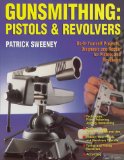
Gunsmithing: Pistols & Revolvers
Top gunsmith Patrick Sweeney provides hands-on pistolsmithing projects for the beginning gunsmith as well as the serious enthusiast. Readers will learn how to clean, polish, and make minor repairs on their pistols. Later chapters cover installing new grips, adjusting trigger pull, fitting target bushings, and other projects. Includes a troubleshooting guide, a glossary of terms, and a directory of suppliers.
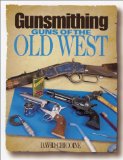
Gunsmithing: Guns of the Old West (Gunsmithing)
Collectors, cowboy action shooters, hobbyists and Old West re-enactors will demand this guide to repairing and improving Old West firearms. More than 40 original and replica guns are covered. Step-by-step detailed illustrations demonstrate to amateur and advanced gunsmiths how to repair and upgrade Old West firearms. This valuable knowledge is passed along to readers by a true working professional with a long history of quality custom gunsmithing work. Features: coverage includes over 40 original and replica guns of the Old West; step-by-step detailed illustrations demonstrate how to repair and upgrade antique and replica firearms; must-have knowledge for anyone working on their Old West firearm or having it repaired or improved.
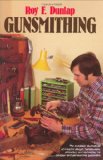
Gunsmithing
Professionals and amateurs looking for a complete, one-book reference will find Gunsmithing is made to order. Beginning with a guided tour of the standard workshop, Dunlap leads gun fixers and improvers to and through 36 chapters on basic and special tools, sources for supplies, and shop practice. It’s all here: how to fix, modify, repair, restore, rebuild and customise firearms of all kinds. Tables, chamber drawings, cartridge data, testing facilities, and data sheets complete this encyclopaedic volume.
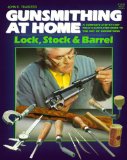
Gunsmithing at Home Lock Stock & Barrel: Lock, Stock & Barrel
Gunsmithing At Home: Lock, Stock & Barrel is a complete step-by-step fully illustrated guide to the art of gunsmithing. Gunsmiths repair, refinish and/or customize any type of firearm. In the majority of cases, it’s a matter of replacing broken or worn out parts. The remaining 25% of a gunsmith’s work deals with customizing existing firearms. Gunsmithing At Homeisn’t just for the professional; it’s designed to give comprehensive assistance to many levels of expertise. Hundreds of photographs and illustrations tied into the clearly written text will guide the gunsmith through setting up his shop to solving the problem at hand — including cleaning firearms, installing and adjusting rifle sights, trigger adjustments and repairs, firearms disassembly, soldering and brazing, metal hardening and tempering, making and fitting replacement parts, rebluing and browning gun metal, metal polishing, stockwork-shaping, and more! Gunsmithing At Homeis the do-it-yourself reference guide and “how-to” book for anyone interested in the art and craft of gunsmithing.
Gunsmithing: Rifles
Gunsmithing: Rifles takes a look at all major rifle types and gives you practical information on how to make repairs, improve performance and modify your rifle to fit your needs.
Practical Gunsmithing
An essential reference for everyone interested in guns, this complete reference shows how to repair, improve, customize, and alter firearms. Complete troubleshooting information about problems such as misfiring and feeding and extraction failures is provided, along with tips for mounting a scope, fitting grips, and more.
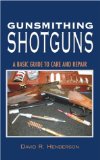
Gunsmithing Shotguns : A Basic Guide to Care and Repair
Every hunter has a gun he wishes he could tune up, whether it’s the ugly old piece that shoots straight, or the beauty which can’t hit a thing. This book is, pure and simple, an attempt at expanding any hunter’s knowledge of gunsmithing. It’s an overview designed to provide insight, ideas, and techniques that will give the amateur gunsmith the confidence and skill to work on his own guns.
In clear and accessible terms, Henderson explains everything from setting up the small gunsmithing shop to building special purpose guns. Topics covered include: shotgun types and maintenance; general trouble shooting; common problems; special challenges; stocks and woodworking; soldering and brazing; basic metal polishing; barrel work; blueing and plating; trigger work; scope mounting; recoil reduction tips; building a special purpose gun.
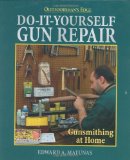
Do-It-Yourself Gun Repair
Now you can learn to diagnose and repair a wide variety of hunting firearms in the convenience of your home workshop and save yourself a bundle of money, too. Worn or broken parts? Less-than-perfect accuracy? A crack in your stock? No problem! With the detailed information and clear, step-by-step illustrations in this authoritative guide, you’ll learn to identify and correct common problems quickly, easily and safely. Find out what tools you’ll need, how to set up your work area, which supplies to keep on hand, how to make basic and advanced gun repairs and more. You’ll also find instructions for the disassembly, repair and assembly of seven of the most popular firearms such as the Remington 700, 1100 and 870; Winchester 94; Savage 110 and Marlin 336 and 70, much of which can be applied to other guns with similar actions. Each entry is lavishly illustrated with photos, drawings, exploded views, a parts list and more. If you’re a hunter or shooter who wants to keep your rifle, shotgun or handgun in top working order, make space for this book on your library shelf.
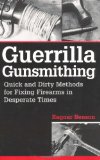
Guerrilla Gunsmithing: Quick And Dirty Methods For Fixing Firearms In Desperate Times
There may come a time when government restrictions severely limit not only access to firearms but the tools and means to repair and maintain them, or you may someday find yourself in the boondocks with a busted weapon. That’s where the guerrilla gunsmith comes in. Ragnar Benson has had experience fixing “junk” guns in some tough places around the world, and here he shares some innovative ways to patch up, cobble together and otherwise make operational everything from antique rifles still found in remote war zones to modern firearms suffering from appalling abuse. Drawing on lessons and stories from backwoods experts he’s worked with under desperate conditions in Africa, the Philippines, Thailand, Pakistan and beyond, Ragnar tells how to employ last-resort but effective techniques to remove hopelessly stuck rounds and other barrel obstructions, straighten bent barrels, replace lost parts, smooth out dented magazines, make repairs to some pretty hopeless stocks, scrounge up workable ammo and more. These are last-ditch, do-it-yourself methods, but they may be all you’ll have to fall back on deep in the bush or with your back to the wall, when the only things between you and the enemy are a rifle and the know-how to make it work.
